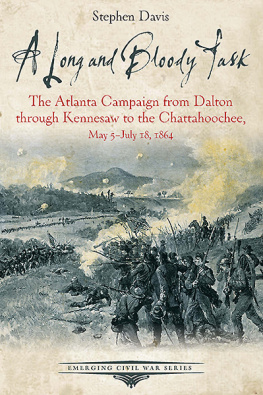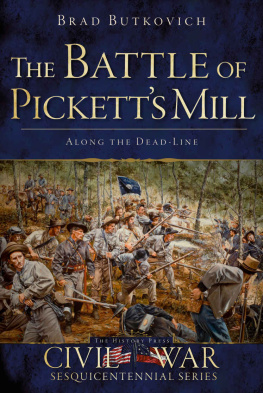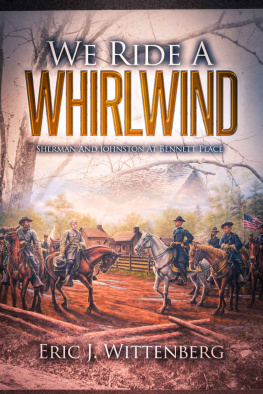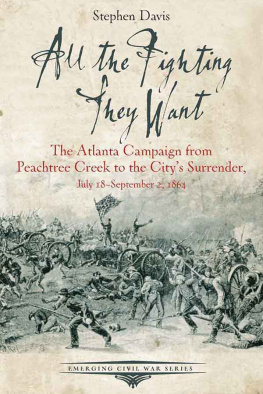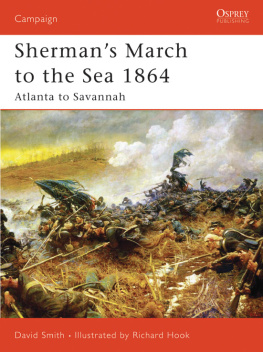Kennesaw Mountain
CIVIL WAR AMERICA
Gary W. Gallagher,
Peter S. Carmichael,
Caroline E. Janney, and
Aaron Sheehan-Dean,
editors
2013 Earl J. Hess
All rights reserved
Set in Miller, Willow, and Copperplate
by Tseng Information Systems, Inc.
Manufactured in the United States of America
The paper in this book meets the guidelines for permanence and durability of the Committee on Production Guidelines for Book Longevity of the Council on Library Resources.
The University of North Carolina Press has been a member of the Green Press Initiative since 2003.
Library of Congress Cataloging-in-Publication Data
Hess, Earl J.
Kennesaw Mountain : Sherman, Johnston, and the Atlanta Campaign / Earl J. Hess.
p. cm.
(Civil War America)
Includes bibliographical references and index.
ISBN 978-1-4696-0211-0 (cloth : alk. paper)
ISBN 978-1-4696-0212-7 (ebook)
1. Kennesaw Mountain, Battle of, Ga., 1864. 2. Atlanta Campaign, 1864. I. Title.
E476.7.H47 2013
973.7371dc23 2012037476
17 16 15 14 13 5 4 3 2 1
For Pratibha and Julie
Contents
Table and Maps
TABLE
Confederate Fortified Lines from Dalton to Kennesaw Mountain
MAPS
Dalton to Marietta
Closing on Marietta
Four Confederate Lines
Kolbs Farm
Kennesaw Line
Confederate Troops on Cheathams Hill
Fifteenth Corps Attack
Sixteenth and Seventeenth Corps Demonstrations
Fourth Corps Attack
Fourteenth Corps Attack
Operations South of Kennesaw
Flanking the Confederates
Kennesaw Mountain Today
Federal and Confederate Works near Big Kennesaw
Pigeon Hill
Gists Salient
Horseshoe Salient
South of Noyes Creek
North and South of Dallas Road
Cheathams Hill
Upper and Lower Artillery Emplacements
Illustrations
William T. Sherman
Joseph E. Johnston
Lost Mountain from Kennesaw
Confederates dragging guns up Little Kennesaw
Confederate artillery position on Little Kennesaw
Carter L. Stevenson
Big and Little Kennesaw
Confederate trench
Little Kennesaw and Pigeon Hill
Big Kennesaw from the east
Pigeon Hill and the open field
Giles A. Smith
Cockrells trench on Pigeon Hill
George D. Wagner
Truce on Fourth Corps sector
Dan McCook
Federal approach to Cheathams Hill
View from Cheathams Hill
John M. Schofield
Barnards photograph of Confederate works on Kennesaw
Rocky Confederate trench
Traverses at Dead Angle
Barnards photograph of Federal works near Hardage House
Tree growth on earthwork remnant
Confederate trench with no ditch
Preface
Six weeks after setting out from Chattanooga in early May, 1864, Major General William T. Sherman hit a massive roadblock while fighting his way toward Atlanta. Confederate general Joseph E. Johnstons Army of Tennessee was heavily fortified along a line that stretched across the Georgia countryside, anchored on the twin peaks of Kennesaw Mountain near Marietta. It was the ninth fortified position Johnston had created thus far in the campaign, and it proved to be the most difficult to bypass. For two weeks, from June 19 to July 3, Sherman tried to find a way to turn Johnstons left flank. Both armies were stretched to the breaking point in their extended positions as artillery duels, constant sniping, and a fierce battle or two erupted. As the two sides tested each other, heavy rains descended, and the dirt roads of Georgia became quagmires. Frustrated at the delay, Sherman decided to try a major frontal assault against three points of Johnstons line on June 27. The Federals who survived that day would remember the attack for the rest of their lives.
The assault of June 27 was a significant departure from Shermans mode of operations during the Atlanta campaign. He had more often maneuvered parts of his massive force, an army group consisting of available troops from the departments of his Military Division of the Mississippi, in order to turn enemy flanks and force the Confederates out of their trenches. Sherman did mix attacks with his turning strategy at Dalton, Resaca, New Hope Church, and Picketts Mill, but most of those assaults had been exploratory efforts to find and develop enemy lines and take advantage of opportunities that occurred. On June 27, the Federals knew what to expect and were hitting a heavily fortified, well-manned position. It was, in a way, an experiment, and Sherman arrived at the decision after many days of deliberation.
Sherman threw eight brigades of veteran troops, some fifteen thousand men, at three locations along the heavily fortified Confederate line on June 27. They failed to make a dent in the defenses, losing about three thousand casualties in the process. Only at one location, a small rise of ground that came to be called Cheathams Hill, did the Federals stay close to the Confederate works after their attack. They dug new field works within yards of the Rebels. Here they stayed for the remainder of the Kennesaw phase of the Atlanta campaign, sniping, digging a mine with the intention of blowing up an angle in the Confederate works, and cooperating with their enemy in burying the many bodies of Union men killed in the attack. When Sherman resumed his practice of flanking Johnston out of his works, the Confederates evacuated the Kennesaw Line on the night of July 2 and retired a few miles to the next fortified position. The Chattahoochee River, the last natural barrier to Shermans approach to Atlanta, lay only a short distance farther south.
The purpose of this book is to tell the story of Kennesaw Mountain in the Atlanta campaign. It is based on extensive research in archival collections and published primary sources. The work of previous historians who have written on the campaign is also incorporated for context. Special attention is devoted to the engagements at Kolbs Farm on June 22 and Shermans assault on June 27. The battlefield itself presented a valuable resource for understanding the action around Kennesaw in late June and early July 1864. Although the area where Shermans right wing tried to find and flank Johnstons left has been developed, the ground within the park is well preserved. The locations of the three attacks on June 27 are in a natural state, even if the site of the battle of Kolbs Farm is a mix of natural landscape and housing development.
The aim of this book is not only to describe the actions along the Kennesaw Line but to explain the significance of the Kennesaw phase of the Atlanta campaign and understand the outcome of operations along the line. By necessity, it is a study of high-command problems, decisions, and triumphs on both sides of no-mans-land. But it is also a story of common soldiers enduring and adjusting to the special rigors of continuous contact with the enemy, living within holes while spring weather did its worst overhead. The endurance of the Federal rank and file was most severely tested by the order to approach well-constructed earthworks filled with Confederate soldiers, and the attack of June 27 serves as an excellent case study of the experience of battle. The use of field fortifications on the minor tactical and the larger strategic level is a major feature of this story, and the failure of column formations to give the Federals an advantage in their risky assault is highlighted. Shermans recurrent fights with newspaper correspondents came into play during the Kennesaw phase of the Atlanta campaign, and neither he nor Johnston could ever forget that higher-level authorities in Washington and Richmond kept watch over their every move. For Sherman, Kennesaw was a dangerous phase of his career, a time when he feared that weather conditions and Confederate fortifications had slowed his advance so much that Johnston might send reinforcements to General Robert E. Lees army in Virginia. For Johnston, Kennesaw represented the best evidence he could muster to prove that his Fabian tactics were working to slow the Union advance into Georgia and were punishing the enemy with heavy casualties. There was much to be gained or lost for both commanders, depending on how this phase of the struggle for Atlanta came out.





